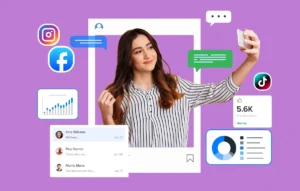Apply For Scholarship
Apply For Scholarship
What is influencer marketing?
Influencer marketing is a digital marketing technique in which brands partner up with individuals who have a strong online presence and hold influence over a set of people. Such individuals are called influencers. They can be celebrities, industry experts, content creators, and also everyday people who have worked hard and built a solid follower base for themselves on platforms such as Instagram, YouTube, TikTok, LinkedIn, or a blog.


Types of influencers based on their follower count are as follows:
1- Nano Influencers
2- Micro Influencers.
3- Macro Influencers
4- Mega or Celebrity Influencers
Essential actions for creating an effective influencer marketing strategy.
Determine your objectives before reaching out to influencers.
The following are common objectives: increasing awareness of the brand.
Increasing website traffic and producing leads or sales
Increasing the number of followers on social media
Increasing interaction (likes, comments, and shares)
An illustration of this would be a skincare company looking to use Instagram Reels to increase sales of a new product line.
Understand your target audience’s demographics.
Location, gender, and age
Interests (fashion, gaming, fitness, travel, etc.)
They enjoy spending time on social networking sites.
A fitness app that caters to those aged 18 to 35 who follow fitness-related information on social media serves as an example.
Reach: Is their following sufficient for your campaign?
For instance, instead of a celebrity with a low level of interaction, pick a micro fitness influencer with 50,000 active followers for a new protein drink.
Choose the amount of money you will give the aforementioned influencers.
monetary payment.
free goods.
commission for affiliates.
long-term collaboration.
Collaborate with influencers to produce authentic content. Product reviews and unpacking are two examples of campaign types.
competitions, giveaways, and contests.
Videos from behind the scenes
Affiliate connections and discount vouchers.
For instance, a fashion firm requests that influencers share a discount code with their followers and style three reels of clothing.
Instead of depending entirely on the influencer’s content, repurpose it:
Share content for your brand on social media.
UGC-based advertisements are the most effective!
Add social proof to your website or blog.
Measure your progress with metrics.
Impressions & Reach (brand awareness)
Rate of engagement (likes, shares, and comments)
Clicks and traffic (landing pages, website visits)
Sales and conversions (with UTM links or discount codes)
Return on Investment, or ROI
Influencer marketing is now more than just a fad; it’s a potent tool for companies looking to establish credibility and establish genuine connections with their target demographic. At NDMIT, Laxminagar, Delhi, you can acquire useful, industry-ready influencer marketing tactics to stay ahead in the digital age. The correct skills and strategies are essential to fully utilizing its potential. Learn that with the best digital marketing course at NDMIT Laxminagar, Delhi.

It works because influencers already have the trust of their audience. Their recommendations feel authentic and drive higher engagement compared to traditional ads.
Look for alignment in values, niche relevance, audience demographics, engagement rate, and authenticity rather than just follower count.
It works because influencers already have the trust of their audience. Their recommendations feel authentic and drive higher engagement compared to traditional ads.
Platforms include Instagram, YouTube, TikTok, Facebook, LinkedIn, and Twitter/X, depending on your target audience.
Costs vary depending on the influencer’s reach, platform, and content type. Nano and micro-influencers may charge less or even accept free products, while macro/celebrity influencers charge higher fees
Asia’s Leading Digital Marketing & Data Science Institute
A comprehensive methodology with the best curriculum, designed according to current corporate demands and needs. [Privacy-Policy]
Copyright © NDMIT Edusoft Private Limited